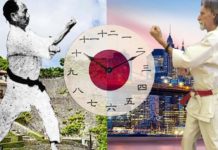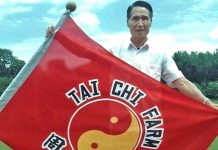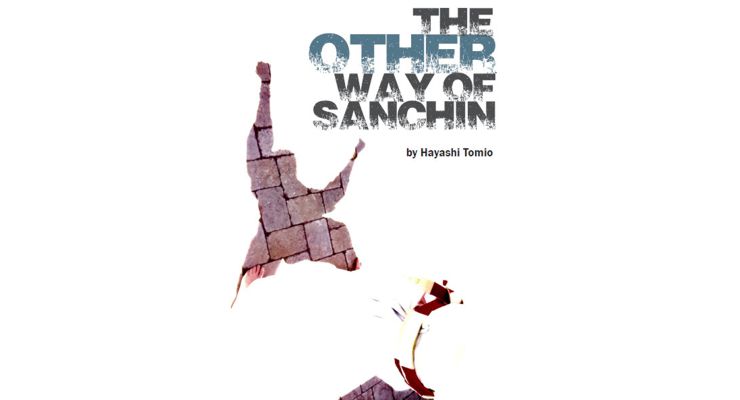 Many karate systems teach the Sanchin kata as an external training method to strength-condition practitioners with a series of breath-controlled tensions. This mainstream understanding is a viable but topical explanation missing some of Sanchin Kata’s other, more dimensional, qualities rooted in the monastic martial culture and in combination with scientific breakthroughs regarding human performance. I would like to broaden this form’s current, pervasive and surface interpretation that many of its contemporary teachers have come to believe defines the entirety of their Sanchin kata practice. I call this alternative methodology the ‘Other Way’ of Sanchin.
Many karate systems teach the Sanchin kata as an external training method to strength-condition practitioners with a series of breath-controlled tensions. This mainstream understanding is a viable but topical explanation missing some of Sanchin Kata’s other, more dimensional, qualities rooted in the monastic martial culture and in combination with scientific breakthroughs regarding human performance. I would like to broaden this form’s current, pervasive and surface interpretation that many of its contemporary teachers have come to believe defines the entirety of their Sanchin kata practice. I call this alternative methodology the ‘Other Way’ of Sanchin.
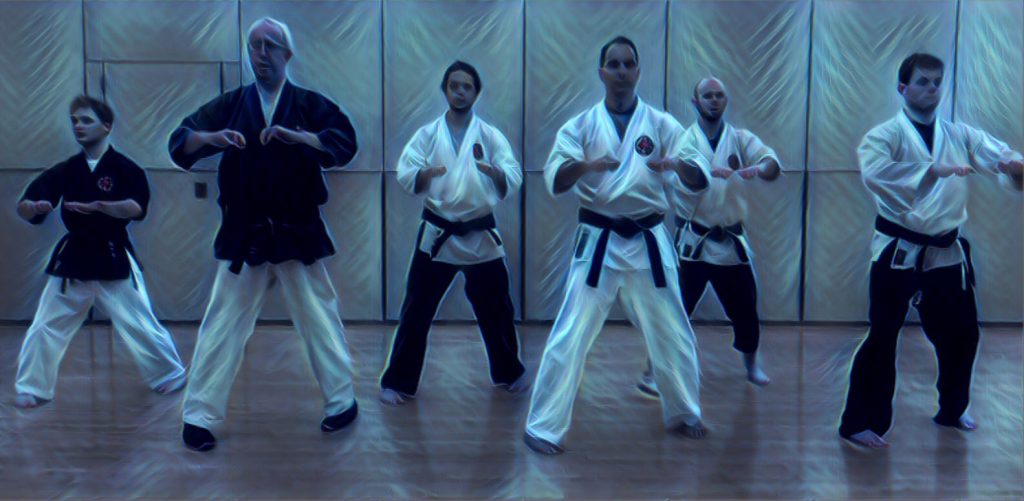
Modern students of Sanchin can often find themselves perplexed about the rationale behind this kata. And few advocates can explain why their Sanchin kata was created precisely the way it is patterned.
THE FOUR MASTERS
A noteworthy exhibition of Sanchin kata, was given in the UK in 2007, involving four notable masters; Master Morio Higoanna (Gojuryu), Master Shinyu Gushi (Uechi Ryu), Master Chen Jian Feng (Da Yu Wu Zu Quan) and Master Pan Cheng Miao (Yong Chun White Crane).
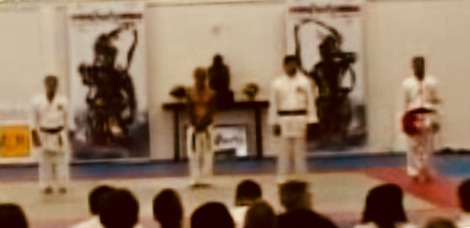
This exhibition was telling about the existing diversity surrounding Sanchin’s performance within the Chinese and Okinawan martial communities. The audience is clearly shown a variety of how-to by established masters, but offered little explanation for why—the most crucial reason to practice this form.
Given the importance of Sanchin in Okinawan martial history, one would think a wealth of explanation existed for discussion yet, more often than not, when encountering Sanchin in a dojo or visual media, scant direction is given beyond broad strokes of its historical significance followed by painstakingly detailed how-to performances of the form’s bio-mechanics.
If the lack of explanation or purpose doesn’t raise questions for practitioners of Sanchin, consider the number of variants in existence. At a cursory glance we have: open hand/closed hand versions; long (with turns)/short (without turns) versions; Hard (Go)/Soft (Ju) methods; Chinese/Japanese/Okinawan variants; Sanchin as a Sai kata vs. weaponless or empty-handed form; Sanchin beginning with right foot lead/left foot lead; Biomechanical vs. Energetic or Ki-focused Sanchin; breathing emphasized/and/or tension-emphasized; bunkai oriented/Buddhist meditation-oriented; Uechi ryu/Gojuryu/Isshinryu/ Shorinryu/ Shitoryu, etc. variants; ¼ crescent stepping (Shitoryu) vs full, ½ circle crescent stepping; Sanchin w/five punches, Sanchin w/seven punches; an original Goju version with one Dharma Wheel at the end vs. Miyagi’s two Wheels and Kichiro Shimabuku’s three Dharma Wheels. Even within the same karate systems further variations can be found. The list of diversity is lengthy.
Do we assume all these variants achieve the same goals or do they have different objectives? Is there any way to determine a hierarchy of values for each of these variations? How much modern marketing hype shadows Sanchin’s real nature?
SANCHIN’S TENSIONAL INTEGRITY
There are two fundamentally different foci martial artists have undertaken with Sanchin kata. The most common is Sanchin’s biomechanical nature, its musculo-skeletal functionality or the bio-tensegrity of its limb alignments. The word ‘tensegrity’ means tensional integrity.
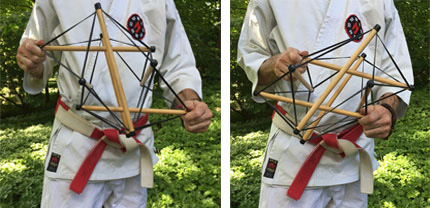
The biotensegrity concept was first introduced by the inventor Buckminster Fuller (1895-1983). Fuller posited that our bodies are mainly tensegrity structures where the fascia and muscle tissue pass load directly to each other rather than through the bones which act only act as spacers held together by soft tissue. The principle of biotensegrity challenges the common belief that the skeleton is a load-bearing structure like the frame of a house. Sanchin aligns with this biotensegrity principle. It optimizes the body’s structure with precisely angled limbs to better withstand the compression of grabs, strikes, pushes and pulls, and to apply these same techniques more forcefully. This worthy study has been the primary focus of most Western Sanchin practice.
But there is another, equally valid focus— Sanchin’s Internal, or Kiko nature, what we call Sanchin’s bioenergetic functionality. These two distinctly different yet complementary and intersecting functions have led to some confusion about Sanchin’s place in a kata curriculum.
SANCHIN AS A YANTRIC FORM
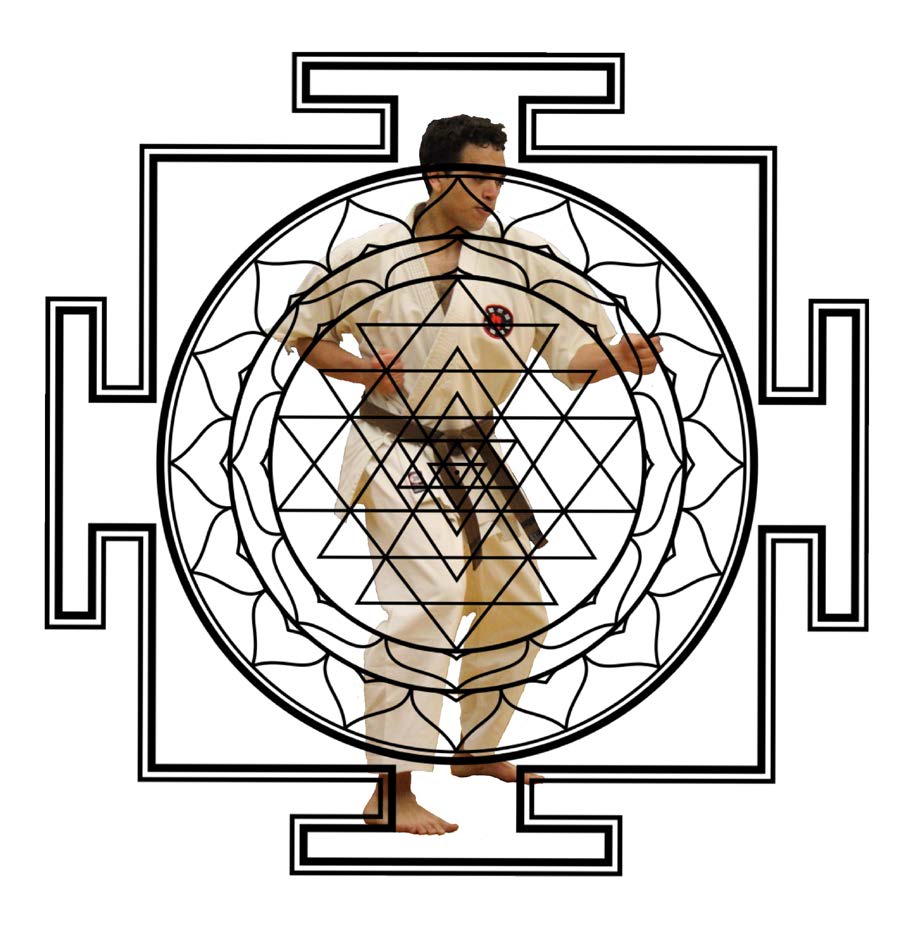
A yantra is a sacred symbol or diagram interacted with either visually or kinesthetically, that is, by doing it. Although kata floor patterns are rarely thought of as Yantric diagrams, Sanchin can be. Most kata today are void of their yantric significance due to a lack of understanding of how intrinsic energy principles function within physical movement patterns. Sanchin however, maintains much of its yantric value both in its long and short variations, particularly when performed as a Ju (Soft) variant. Sanchin’s short version embusen (lines of motion) is simple; three steps forward, two steps backward—otherwise, a straight line. The longer version adds two additional angles or three directional turns, covering North, West and East— if the practitioner initiates the Form facing compass North. The kata’s embusen forms a cross. Any kata begun facing different directions will activate different meridian channels. The directional factor alone makes Sanchin’s embusen a yantric pattern.
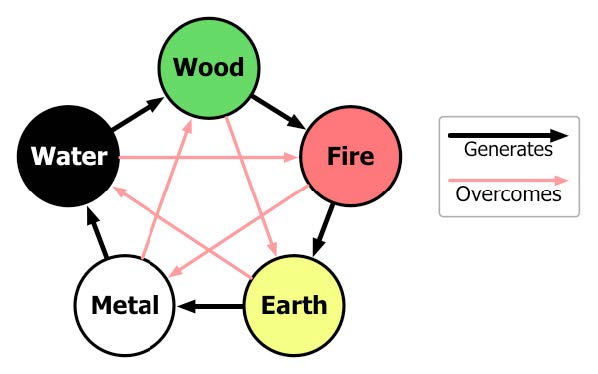
Sanchin is rich in symbolism. Its five steps equate to the Chinese Five Element Phases. The Form’s three distinct sequences also refer to the trinity of Hindu Deities: Brahma, the Fire god; Vishnu, the Wind god; and Shiva, Heaven’s custodian enacting the cycle of Creation and Destruction. Putting this symbolism aside, there remains a unique martial language being conveyed alongside, and in accord with, Sanchin’s familiar biomechanical model of breathe/tense. Most Western sensei are not aware of this other way, this hidden language of Sanchin. However, a slowly growing minority of teachers are dusting off the ambiguity and misassumption about this Form’s true place in their martial curriculum.
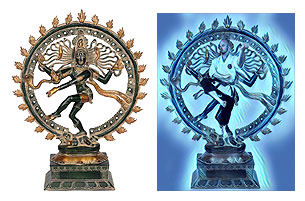
Sanchin is a noted Kiko (Chi Kung) form. Its root performance is designed to gather, to cultivate, and to express internal power principles in a precise and sequenced manner. The overall idea of three levels, layers, or battles defining the word sanchin, is to integrate the body’s mental, physical and ‘spiritual’ or quantum energy systems to generate unusual strength for a defensive advantage. Sanchin is designed to weave the respiratory process into and accord with the musculo-skeletal system, and the mind’s intention-generating, communications networks along with surrounding field forces. Its movement sequence is patterned to clear the pathways for optimal health and physical vitality.
The focus of Sanchin’s strength-generating lessons lies upon developing the proper awareness to activate the subtle human energy fields, not just the gross musculature, as often espoused in a bluntly put, Western style, no pain/no gain, vein-pumping workout. By cultivating sensitivity and with precision body sequencing, the Sanchin kata teaches one how to manipulate and direct some measure of the body’s self-generated electro-magnetic fields to affect the physiology of the muscles. This is an entirely new language being introduced to describe the purpose of Sanchin—one in my opinion, greatly clarifying.

The musculature of the human body, although seeming symmetrical, is often energetically asymmetrical, unequal in strength from right to left side. This has less to do with the body’s obvious, bilateral anatomical musculature, but rather with the charge being supplied to the muscles. In other words, muscles may be of equal size on the right and left sides of your body but unequal in charge at any given moment. We can call this invisible charge and the process of muscular charging, ‘Ki’. Though the science behind Ki still remains a mystery, its martial influence and behaviors have been well-defined and documented by the slowly disappearing neijia (internal) family systems of China.
To enhance the contractibility of a muscle, new emerging scientific theories are suggesting that the conventional, neuro-chemical impulse to contract a muscle may not be the only active, signaling or communication system.
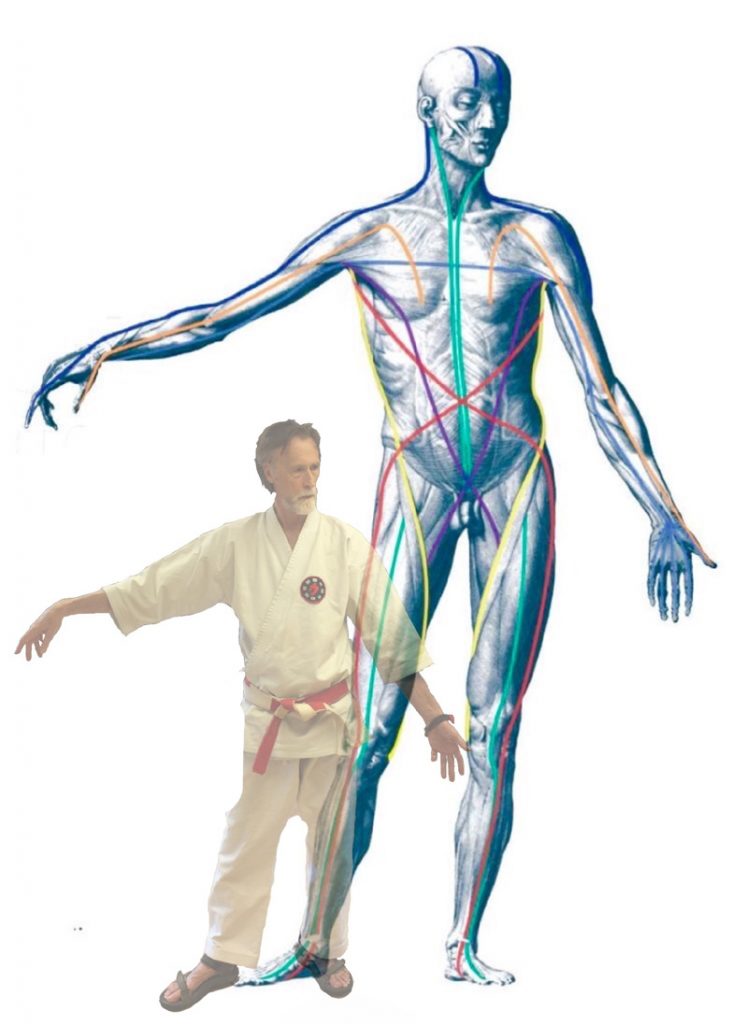
What constitutes this other system or systems and how does this communication take place? One theory is that the body communicates via the acupuncture meridian channels. Another is via the body’s fascial network, what is known as the Anatomy Train. The fascia, our connective tissue system, has been noted to carry an electro-magnetic charge more rapidly than the brain’s neuro-chemical network.
Equally fascinating is the discovery by the bio-physicist, Fritz Albert-Popp, that photons, light particles without mass, could carry and transmit information within and between cells. Popp called the storing and releasing of photons ‘bio photonic emission’. He found that DNA uses a range of frequencies as an information tool suggesting a communication feedback loop through waves, which encode and transfer information between cells.
Biophotonic emission is a perfect communication system with the potential to transfer information to cells across the body—even to other bodies.
Fascinating laboratory studies conducted in Northern California with high level internal martial artists have revealed their ability to emit photons from their body—at will. How, why, and to what effect, might begin to explain the unusual strengths and feats of some practitioners.
Whether electro-magnetic, chemical, photonic, neural, all four, or otherwise, during the opening move of Sanchin, a muscular charge is built up and distributed through a combination of intention, deep relaxation and three simultaneous physical actions; a deep belly in-breath, a proper crescent step, and the rotation of the lead foot’s heel outward. When done with proper sequencing, the right leg’s Yin meridians are switched on, signaling a charge to a specific muscular chain, giving the muscles along this network greater contractibility. (Note: the Sanchin variation being discussed begins with a right foot forward.)
Where the science of Ki still remains in a theoretical arena, the outcome of its activation has been proven in thousands of tests using subjects of all ages and martial skill levels. For example, when Sanchin’s opening crescent step is performed correctly, most students will demonstrate a noticeable, even remarkable and instant increase in physical strength—for certain actions.
“In this new model weakness is seen
as the wrong communication,
the wrong polarity,
the wrong muscles being charged.”
On one plane of the internal power perspective, physical strength can be divided into two categories; Yang-oriented strength and Yin-oriented strength. Simply put, physical strength can be divided into pushing versus pulling actions. Without complicating this, to push or punch harder, Ki must be distributed to the front of the body. To pull harder, Ki must be distributed to the back of the body. Specific limb and torso actions, breath manipulation, mental visualizations and intentions will bring this shift about. Sanchin’s limb actions activate and maximize the proper distributory meridians or ‘Strength Channels’ to produce heightened results.
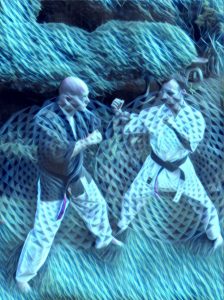
In this new model, weakness is seen as the wrong communication, the wrong polarity, the wrong muscles being charged. In the dojo we commonly understand correct limb action as, “good form.” We can now further add, “good charge!”
Sanchin’s opening punch sequence activates Yang strength. The second spear/press sequence activates Yin strength. The final Dharma Wheel rotation of the hands activates both channels simultaneously.
Consider there are numerous Sanchin formulas to achieve this distribution. But no matter how much they appear varied on the outside, they must all follow certain energetic guidelines to be an authentic internal Sanchin.
Most people are right-handed. The right arm is generally stronger and therefore used as an extensor/offensor and hence the preferred punching mechanism in most karate systems. The left side was always the preferred retractor and hence its role as the defensor/receptor, being its primary use as the blocking or parrying tool. The salutations of some schools often indicate this distinction in their opening gestures by presenting a left (Yin) open hand and right (Yang) closed fist during the Rei or bowing salute.
The opening crescent step of Sanchin triggers the three meridians; Spleen, Liver and Kidney channels found on the inside of the legs. A crescent step consists of three different leg actions; forward moving, outward moving and rotation. Each action opens one Yin channel. All three channels opened together maximize Ki flow.
Below is a step-by-step breakdown of the initial first step in the kata to help those who only practice a biomechanical-focused Sanchin gain a better foothold of this kata’s inner rationale.
Most Sanchin starts by crescent stepping with the right foot forward into Sanchin dachi from the Musubu dachi (feet v’d and opened 45 degrees). Why the right foot and not the left foot? The right foot forward action represents a Yang formula. Uechiryu Sanchin’s left foot forward presents a Yin formula. Stepping from the feet v’d outward also forces one to make more of a foot rotation, thereby distributing a greater charge up the forward stepping leg.
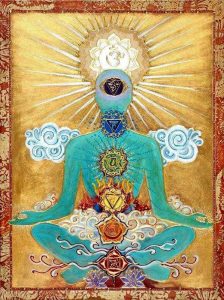
Beyond Sanchin’s obvious composition, and with a cultivated sensitivity, it is possible to detect or feel the functioning of a fluxuating energy field, which we label the Energy Body. Science does not dispute the existence of a human energy or auric field. ‘Energy Body’ is a term we use to describe all unidentified forces involved in enhancing physical strength beyond the obvious musculo-skeletal ones and that project beyond the epidermis. This highly, elastic energy field is influenced by conscious intention and specific limb positioning. The Energy Body can be considered a second, more extensive ‘body’ consisting of various field forces that science refers to as the Biofield. In a healthy functioning individual this biofield forms an energetic matrix surrounding the human form and is most dense within a foot to a foot and a half away from the skin. This field also links cellular activity with meridian pathways.
Our energetic aura acts like a superhighway allowing light speed cellular communication to maintain a coherent holistic intelligence in the organism. It’s quite possible that this cellular communication optimizes our physical tasks with an evolutionary patterning of specific limb actions, which, at its foundation, gives karate kata its unique structure.
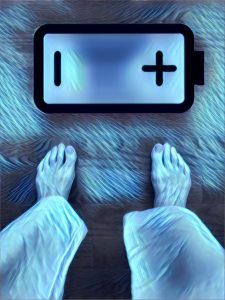
For example, we contend that the right foot steps forward first into the Sanchin dachi because it demonstrates ancient knowledge of how to draw energy into the body from an otherwise Yang (energy-out) action. Turning the right heel out when finalizing the step, effectively converts a Yang/energy-out motion into a Yin/energy-in motion. The energy-in versus out hypothesis is easily testable when you know what you are looking for and it is the foundation upon which karate systems have chosen the left arm as the dominant blocking mechanism.
There are three stages to successfully performing the right foot lead, Sanchin crescent step as an internal practice.
- Draw Ki from the legs into the body core.
- Fill and contain Ki in the dantien.
- Pump Ki into the upper torso and arms.
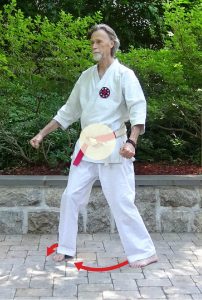
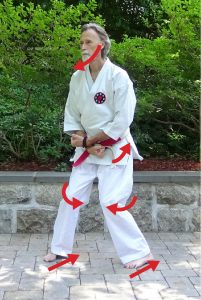
Stage 1 Drawing Ki into the body
First, relax your entire body. Rid yourself of as much tension as you are aware. Open your back by spreading your scapula, sink your chest. Let you belly wall expand. The kata’s opening salutation allows you a brief mind-stilling, mind-calming, meditative moment. Place your tongue lightly to the roof of your mouth. Breathe in through the nose. As you inhale, begin a crescent stepping action with your right foot. It is critical that your crescent action does not lift the foot up more than enough to glide it across the floor’s surface otherwise the energy-draw is broken. The stepping leg is relaxed. Your arc should include your thigh passing, but not touching as close to the opposite thigh as possible.
Allow your knees to fold inward on the step, let your pelvis tilt backward, shift your weight toward your heels and keep your anal sphincter (the anal muscle) relaxed. Draw both your arms inward with your right arm under the left as if gathering something into them. Keep your abdomen relaxed throughout. Do not bend from your waist during this motion but maintain a straight back.
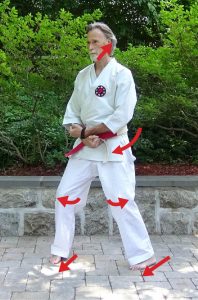
Stage 2 Filling and containing Ki in the Dantien
As soon as you reach the end of your inhale, your arms should cross left on top of right just below your dantien. Now, tuck your pelvis forward, shift your weight to the balls of your feet. Tighten your anal sphincter. This action seals Ki in the dantien and prepares it for distribution into the upper torso.
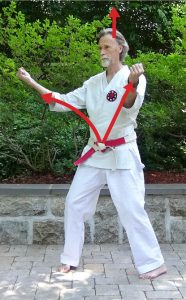
Stage 3: Distributing Ki to the upper torso and arms
Exhale and press your knees outward. Rise upward with your legs with a straight back. Lift your head upwards and draw your chin back toward your neck. Lift your arms in a crescent action moving them from the center of your torso outward in a rising arc into a double, closed-hand middle block.
If you did this sequence successfully your musculature will be charged for pushing, punching, splitting and lifting actions with far greater power.
Following the principles of a Ju or soft version Sanchin, the only tension should be on the muscles necessary to do the actual steps. The rest of the body should be free of all tightness. The Go or hard version requires a different breathing pattern called ibuki while body tension is held throughout the performance.
Uechiryu Sanchin starts with a left foot forward. Uechiryu reverses the breathing pattern and motion of the arms to accomplish the same goal. Uechiryu’s left foot step reveals a Yin formula. An initial right step is considered a Yang Sanchin.
It’s important for practitioners to understand that one should not blend elements from one Sanchin system into another. You will get mixed results, or worse, you will flip strength gains into strength deficits.
How do you know if you are properly activating the Subtle Energy systems in your Sanchin?
The first hurdle to overcome is to learn how Sanchin functions as a Kiko form. Without this knowledge only the kata’s outer or biomechanical fundamentals will be practiced and you will have no way of knowing if subtle energies have been properly activated or not.
Unless you are a highly sensitive person, you will need the assistance of someone knowledgeable to test the results of your movement sequence. These tests must also be appropriate to the musculature being charged. Most people lack the sensitivity in the early stags of internal Sanchin training to sense the charge in the appropriate muscles.
ALL FIRED UP
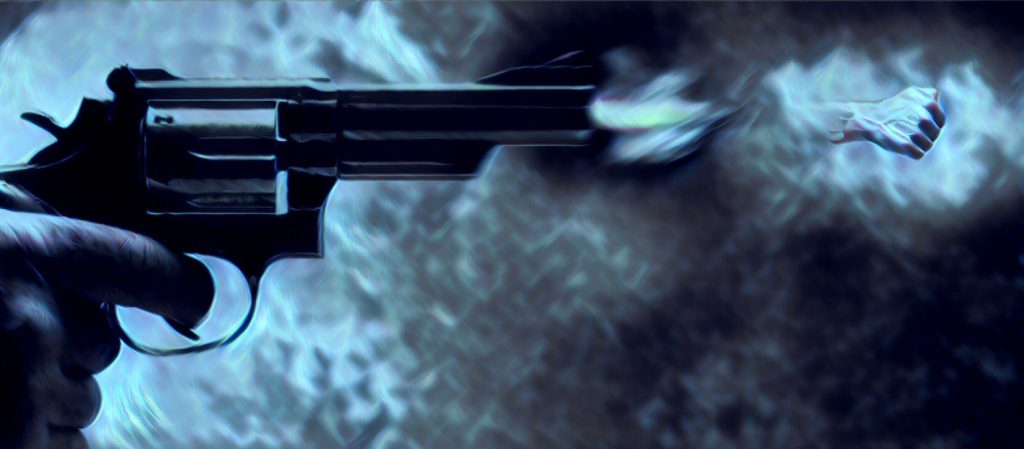 Technological and scientific breakthroughs bring us closer every year to understanding the hidden triggers of peak athletic performance. Some practices are startling because of their subtlety and unpredictable influence. For example, exercise scientists have demonstrated that a weightlifter’s maximum strength can be enhanced nearly 7.5% if a starter pistol is unexpectedly fired just prior to the lift. Flashing smiles on a screen at the imperceptible speed of 16 milliseconds boosted cyclists performance by 12%. Runners who swished a sport drink during a race performed better if they spit it out near the last stage. Using sound to electrically stimulate targeted parts of a skier’s cerebral cortex is believed to improve their muscle memory.
Technological and scientific breakthroughs bring us closer every year to understanding the hidden triggers of peak athletic performance. Some practices are startling because of their subtlety and unpredictable influence. For example, exercise scientists have demonstrated that a weightlifter’s maximum strength can be enhanced nearly 7.5% if a starter pistol is unexpectedly fired just prior to the lift. Flashing smiles on a screen at the imperceptible speed of 16 milliseconds boosted cyclists performance by 12%. Runners who swished a sport drink during a race performed better if they spit it out near the last stage. Using sound to electrically stimulate targeted parts of a skier’s cerebral cortex is believed to improve their muscle memory.
Even our own perceptions can control our performance. If you think you can do it, your chances of succeeding increase. Affirmative self-talk, and positive visualizations are scientifically proven methods to enhance athletic performance. These once unimaginable, unexplored and/or formerly overlooked arenas are today giving us a stronger foothold into the mind/body connection and its value to athletic outcomes.
Some Asian masters, both monastic and lay, were aware of and could undoubtedly control their subtle energies, or Biofield, for increased strength and endurance, though they would have used different terms to describe the phenomenon. Sanchin kata and others like it, have sophisticated internal principles embedded in them so that practitioners can experience this phenomenon first hand. The revival of this hidden art-within-an-art may just prove to be the most fascinating dimension of Traditional martial study and provide us a unique intersection of ancient knowledge with modern science.
Neihanchi Kata: A Half-Century Musing On The Kata Of Okinawa
Neihanchi Kata: A Half-Century Musing On The Kata Of Okinawa


